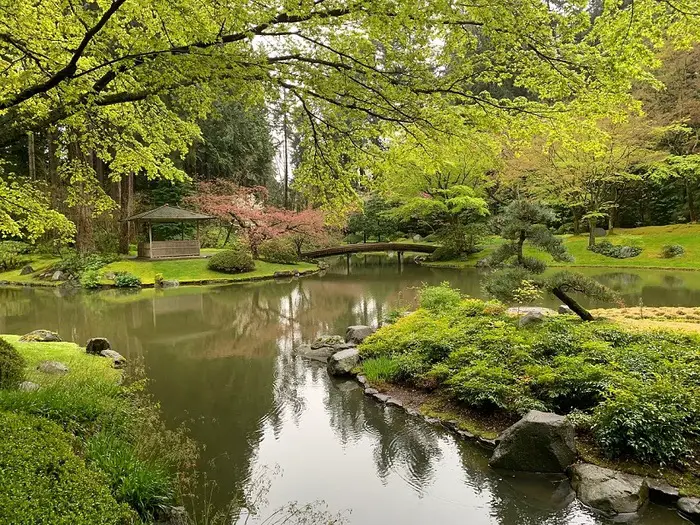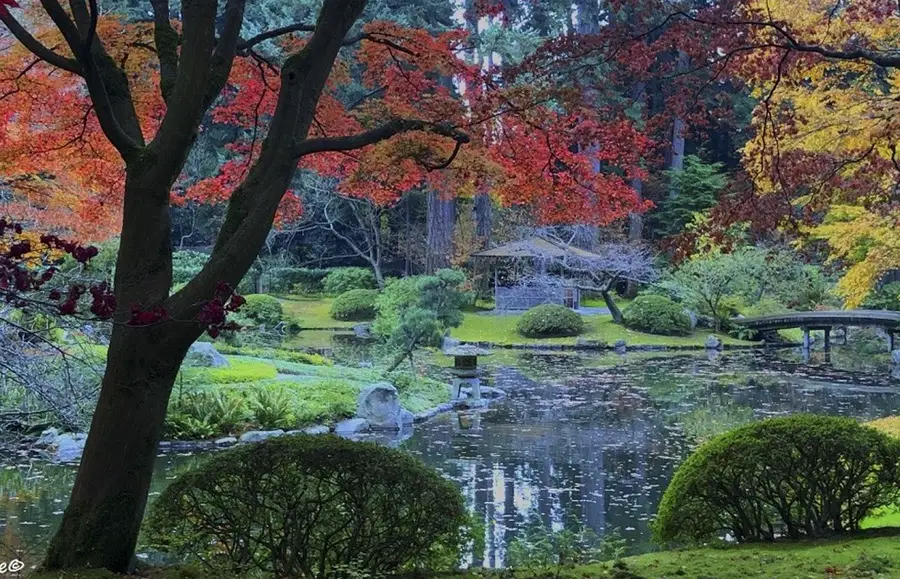Vancouver’s Nitobe Memorial Garden is a hidden oasis in the city. Dedicated to Inazo Nitobe, the Japanese Canadian community created the garden in his honour. It opened on November 2, 1975, with a statue of him by George Tsutakawa and a plaque explaining his contribution.
Introduction
Nitobe Memorial Garden is a hidden oasis in Vancouver that tourists often overlook. Nestled in the heart of the University of British Columbia campus, this Japanese garden is a serene and peaceful spot to unwind and escape the hustle and bustle of city life.
The garden was designed by renowned Japanese landscape architect Dr. Kannosuke Hattori and opened in 1960. It is named after Inazo Nitobe, an early 20th-century educator, diplomat, and author who advocated for international understanding through education and culture.

The garden features traditional Japanese elements such as ponds, bridges, stone lanterns, and lush vegetation. There is also a tea house where you can enjoy a cup of matcha green tea while enjoying the tranquil surroundings.
Whether you are looking for a place to relax or want to learn more about Japanese culture, the Nitobe Memorial Garden is worth a visit.
Nitobe Memorial Garden is a tranquil oasis that transports visitors to different times and places. This stunning Japanese garden is a masterpiece of design and horticulture, showcasing the best of Japanese culture and aesthetics. Whether you’re looking for a peaceful retreat from the hustle and bustle of city life or want to experience the beauty of nature, Nitobe Memorial Garden is a must-see destination.
https://www.youtube.com/watch?v=m9MoagfW-Z8
The philosophy and design elements of Nitobe Memorial Garden
The Nitobe Memorial Garden was designed with the concept of “shakkei” in mind, which means “borrowed scenery”. The garden incorporates elements of Japanese culture, such as the use of natural materials and the placement of rocks and stones. The design also includes traditional Japanese structures such as a tea house and a ceremonial gateway.
The garden is divided into several sections, each with its distinct design elements. For example, the Acer Grove features a collection of various types of maple trees, while the Sand and Stone Garden is a minimalist garden designed to encourage contemplation and reflection. Overall, the Nitobe Memorial Garden is a serene and beautiful place that offers visitors a unique and authentic Japanese garden experience.
Features of Nitobe Memorial Garden
Nitobe Memorial Garden in Vancouver, Canada is a beautiful Japanese garden that showcases a blend of natural elements and traditional Japanese design. Here are some of the garden’s noteworthy features:
The entrance and tea garden
The garden greets visitors with a ceremonial gateway, which leads to a tea garden where guests can sit and reflect on the beauty of the garden. The tea garden features a pond filled with koi fish and a traditional tea house where visitors can enjoy a cup of tea and experience Japanese culture.
The pond and waterfall
The central feature of Nitobe Memorial Garden is a large pond. It is complemented by a waterfall and a stone bridge that allows visitors to walk over the water and take in the serene scenery. The pond is populated with aquatic plants, which add to the garden’s naturalistic beauty.
The zigzag bridge and stone lanterns
Another interesting feature of Nitobe Memorial Garden is the zigzag bridge. It is designed to slow visitors down and encourage mindfulness. The garden also has several stone lanterns which are used to illuminate the garden’s pathways and add to its serene atmosphere.
All of these features come together to create the tranquil and authentic Japanese garden experience that Nitobe Memorial Garden is known for.
Garden Elements and Landscape
Nitobe Memorial Garden is a renowned Japanese garden in Vancouver, Canada, which is known for its exquisite beauty and authenticity. In addition to the garden’s noteworthy features, other elements contribute to its serene atmosphere.
The use of water and the pond’s ecosystem
Water is a crucial element of traditional Japanese gardens. Nitobe Memorial Garden’s large pond is complemented by a waterfall and a stone bridge that enhances the garden’s ambiance. Aquatic plants and koi fish populate the pond, creating an ecosystem that adds to the garden’s naturalistic beauty.
The role of rocks and stones in the landscape
Rocks and stones are also fundamental elements of Japanese gardens. Nitobe Memorial Garden features several rock formations and stone lanterns that add to the garden’s aesthetic appeal. The zigzag bridge is another unique feature that is designed to encourage mindfulness.
The significance of trees, shrubs, and plants
Trees, shrubs, and plants are meticulously selected and arranged in Japanese gardens. Nitobe Memorial Garden showcases a variety of plant species that are typical in traditional Japanese gardens. These plants add texture and color, contributing to the garden’s peaceful atmosphere.
Overall, Nitobe Memorial Garden’s elements and landscape come together to create an authentic and beautiful Japanese garden experience.
Walkways and Pathways
Nitobe Memorial Garden creates a tranquil atmosphere that emphasizes harmony with nature. The garden’s design incorporates pathways that encourage visitors to slow down and appreciate the surroundings.
The garden’s emphasis on tranquility and harmony
The garden’s winding paths and walkways encourage visitors to immerse themselves in the peacefulness of the environment. Nitobe Memorial Garden is designed to evoke a sense of stillness and relaxation that is typical of Japanese gardens.
The garden’s overall layout promotes mindfulness and calmness that visitors can experience through its pathways and walkways.
The use of stepping stones and winding paths
The garden’s pathways are made of natural materials like stepping stones set in gravel or winding paths lined with moss. These elements are not only aesthetically pleasing but also serve a functional purpose by providing stability and a safe surface to walk on.
Visitors can meander through the garden, discovering new viewpoints that provide unique perspectives on the garden’s elements and landscape.
Nitobe Memorial Garden’s mindful design, natural materials, and pathways invite visitors to take a pause from their busy lives and experience the serenity of a traditional Japanese garden.
Japanese Culture and Aesthetics
Nitobe Memorial Garden is a reflection of traditional Japanese aesthetics and culture that emphasizes harmony with nature. From its winding paths to the natural materials used for its walkways, the garden’s design invites visitors to experience mindfulness and tranquility.
The influence of Zen and Shinto traditions on the garden
The garden’s aesthetics are influenced by Zen and Shinto traditions that value simplicity, tranquility, and the natural world. The design’s emphasis on simplicity can be seen in its natural materials, sparse layout, and minimal use of ornaments. Meanwhile, the garden’s emphasis on the natural world reflects Shinto traditions that celebrate the divine in all living things.
The combination of these traditions creates an atmosphere of peace and reverence that is typical of Japanese gardens.
The symbolism behind garden elements and design
In addition to its aesthetics, Nitobe Memorial Garden’s elements and design are imbued with symbolism. The garden’s pond, for instance, represents the sea, while its rocks represent mountains. Similarly, the garden’s use of asymmetry, balance, and open space represents the Japanese aesthetic concept of wabi-sabi, which values imperfection and impermanence.
These elements invite visitors to contemplate the transience of life and reflect on their connection to nature.
Nitobe Memorial Garden’s design and aesthetics reflect the beauty and values of traditional Japanese culture, inviting visitors to experience mindfulness and tranquility in a serene environment.
Seasons and Events at Nitobe Memorial Garden
The garden’s beauty and significance in all seasons
Nitobe Memorial Garden is a breathtaking sight in all seasons, from the cherry blossoms in spring to the colorful autumn foliage. Its design and aesthetics change with time, reflecting the natural changes in the environment.
In the spring, the garden’s cherry blossoms burst into bloom, filling the air with their delicate fragrance. During the summer, the garden’s lush greenery provides a refreshing respite from the heat. In the fall, the garden’s maple leaves turn into a beautiful array of reds and oranges, creating a picturesque scene. Even in the winter, the garden’s stark beauty makes for a peaceful and tranquil visit.
Annual events and traditions at Nitobe Memorial Garden
Nitobe Memorial Garden hosts several annual events and traditions that celebrate Japanese culture and nature. One of the most popular events is the Cherry Blossom Festival in spring, where visitors can enjoy traditional Japanese music and dance performances while admiring the blooming cherry blossoms.
In the summertime, the garden’s Teahouse offers traditional Japanese tea ceremonies for visitors. In autumn, the garden hosts the Moon Viewing Festival, where guests can view the full moon while enjoying poetry readings and traditional Japanese sweet treats.
These events provide visitors with a unique opportunity to immerse themselves in Japanese culture while enjoying the garden’s natural beauty.
Nitobe Memorial Garden’s Legacy
Dr. Nitobe’s legacy as a cultural ambassador
Nitobe Memorial Garden was named in honor of Dr. Inazo Nitobe, a renowned Japanese scholar and diplomat. Nitobe dedicated his life to promoting Japanese culture and values to the Western world through his writings and speeches.
He served as a cultural ambassador and worked tirelessly to build bridges between East and West. His vision for the garden was to create a space that reflected the beauty and balance of Japanese aesthetics, while also promoting cultural understanding and appreciation.
Today, Nitobe Memorial Garden stands as a testament to his legacy and serves as a living example of the power of cultural diplomacy.
The garden’s impact on cultural education and preservation
Nitobe Memorial Garden not only serves as a cultural landmark but also a hub for cultural education and preservation. The garden offers educational programs and workshops that teach visitors about Japanese culture, history, and traditions. It also hosts cultural events that showcase the richness and diversity of Japanese arts and crafts.
By promoting cultural understanding and appreciation, Nitobe Memorial Garden is playing a vital role in preserving Japan’s cultural heritage for future generations. Its influence extends far beyond the garden’s walls, inspiring people around the world to embrace the values and traditions of Japanese culture.
Nitobe Memorial Garden truly embodies the spirit of Japan’s cultural diplomacy and continues to be a source of inspiration and wonder for visitors of all backgrounds and ages.
What is the history of the Nitobe Garden?
The Nitobe Memorial Garden is a traditional Japanese garden on Vancouver, Canada’s University of British Columbia campus. The garden was built in 1960 to memorialize Dr. Inazo Nitobe, an educator and diplomat from Japan who championed international understanding.
The garden features a beautiful koi pond, bridges, stone lanterns, and carefully manicured gardens. It is considered one of North America’s finest Japanese garden examples.
The garden is open to the public year-round and is a popular spot for weddings and other special events.
Nitobe Memorial Garden was created in 1960 in memory of Dr. Inazo Nitobe, a Japanese diplomat and scholar best known for his work, “Bushido: The Soul of Japan.” The garden was designed by Professor Isamu Noguchi, a renowned Japanese-American sculptor and landscape architect, and combines elements of traditional Japanese garden design with modern techniques and materials.
Location and Hours
The Nitobe Memorial Garden is a hidden oasis in Vancouver, nestled in the heart of the UBC campus. The garden is open daily from 10 am to 4 pm, with the last entry at 3:30 pm. Admission is by donation.
The traditional Japanese strolling garden design features a beautiful koi pond, tranquil streams, serene bridges, and carefully manicured gardens. It’s the perfect place to take a break from the hustle and bustle of city life and relax in nature.
UBC is easily accessible by public transit, and plenty of parking options are available on campus. Once you’re here, follow the signs to the Nitobe Memorial Garden – it’s just a short walk from the bus stop or parking lot.

Features of Nitobe Memorial Garden
One of the most striking features of Nitobe Memorial Garden is its water use. The garden is centred around a large pond, fed by a waterfall and surrounded by lush vegetation and rocks. Visitors can stroll along the garden’s winding pathways, cross over arched bridges, and observe the beauty of koi fish swimming in the pond.
Another highlight of Nitobe Memorial Garden is its tea garden, which incorporates traditional Japanese tea ceremony elements. The tea garden consists of a small pavilion overlooking the pond, where visitors can enjoy a cup of green tea and some traditional Japanese sweets while enjoying scenic views.
The garden also features several other traditional Japanese elements, including a stone garden, a lantern collection, and a maple grove. These elements are carefully arranged to create a sense of harmony and balance, a central tenet of Japanese garden design.
How to Get There?
Vancouver’s Nitobe Memorial Garden is a hidden oasis on the University of British Columbia campus. The 5-acre garden is a peaceful retreat from the hustle and bustle of city life, with winding paths, serene ponds and beautiful flowers and plants. The garden is open daily from dawn to dusk, and admission is free.
To get to the Nitobe Memorial Garden, take the SkyTrain to the Commercial-Broadway station. From there, it’s about a 10-minute walk west on West 16th Avenue to the University of British Columbia campus. Once on campus, follow the signs to the garden just south of the Main Library.
What is There?
The Nitobe Memorial Garden is a hidden oasis in Vancouver. The garden is located on the University of British Columbia campus and is named after Inazo Nitobe, a Japanese diplomat and educator. Japanese landscape architect Isamu Noguchi designed the garden, one of the few authentic Japanese gardens in North America.
The garden features a traditional koi pond, a strolling garden, a tea house, and a dry garden. The koi pond is home to over 100 koi fish, considered good luck in Japan. The strolling garden features winding paths and tranquil scenery. The tea house is open for tea ceremonies and other events. The traditional Japanese rock gardens inspire the dry garden and feature gravel instead of grass.
The Nitobe Memorial Garden is a beautiful and serene place to relax and escape the hustle and bustle of city life.
How big is Nitobe Memorial Garden?
Nitobe Memorial Garden is a five-acre Japanese garden on Vancouver, Canada’s University of British Columbia campus. The garden was designed by renowned Japanese landscape architect Dr. Kinsaku Nakane and opened to the public in 1960.
The garden is named after Inazo Nitobe, a Japanese diplomat, educator, and author who wrote extensively on international understanding and peace. He is best known for his book Bushido: The Soul of Japan, which discusses the samurai code of honour.
The garden features traditional Japanese elements such as ponds, streams, bridges, stone lanterns, and maples. It is also home to various plant life, including azaleas, rhododendrons, camellias, and cherry trees.
Is Nitobe Garden free for UBC students?
Yes, Nitobe Garden is free for UBC students! The garden is open daily from dawn to dusk and offers a beautiful respite from the hustle and bustle of campus life. In addition to being a tranquil place to relax, Nitobe Garden is also an excellent spot for studying or working on group projects.
Nitobe Garden admission
The Nitobe Memorial Garden is a beautiful and serene oasis hidden in the heart of Vancouver. The garden is open to the public for a small admission fee, and spending an afternoon exploring this little slice of paradise is well worth it.

The Nitobe Memorial Garden was created in memory of Dr. Inazo Nitobe, a Japanese diplomat, scholar, and educator. The garden is designed in the traditional Japanese strolling garden style, and it features a variety of beautiful plants and trees. There is also a Tea House on-site, where you can enjoy a cup of tea and relax in the peaceful setting.
If you are looking for a place to escape the hustle and bustle of city life, the Nitobe Memorial Garden is worth a visit.
Map
- Yonge-Dundas Square in Toronto is Now Called “Sankofa Square” - December 17, 2023
- Best Western Brooks’ SureStay Plus debuts in Alberta - December 16, 2023
- Air Canada Arrives in Tulum, Mexico as the First Canadian Airline - December 16, 2023




